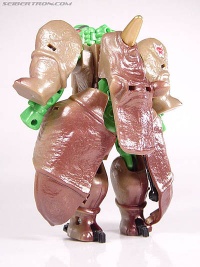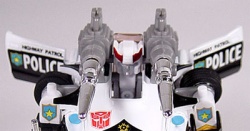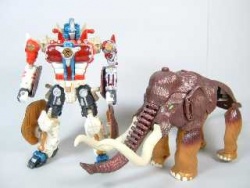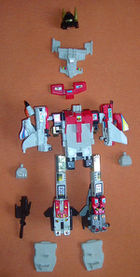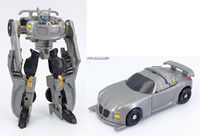Kibble
From Transformers Wiki
Kibble is a feature of many Transformers, both in their toys and in their animation/comic designs. In its modern usage (see below for earlier meanings) it refers to pieces which have no clear purpose in one mode but are there only because they are part of another mode. In most cases, "kibble" is used to refer to pieces of the character's alternate mode which "hang" or stick out in their robot mode. Sometimes these pieces are there as a matter of aesthetics, and sometimes it's simply because there wasn't any place better to put the stuff.
Much less frequently, the word is used to refer to "robot parts" which are badly hidden in an altmode. This is most common in figures with aircraft altmodes, where whole limbs or compressed torsos were left exposed on the underside. In this case, the term undercarriage junk is more often used. During the Beast Wars era, the term was also applied to any figure with robot mode limbs hanging from underneath the animal mode shell.
Parts of one mode which are merely visible in other modes are not necessarily kibble. For example, an altmode part which is well-integrated into the robot's form—like the front of a car or truck that becomes a character's chest—is not kibble because it is an integral part of the robot's body, rather than being "tacked on".
When "kibble" entered the Transfan lexicon, it had a different meaning, and referred to a Transformer's accessories and detachable parts which had nowhere to go when not attached/worn/held. This meaning has almost, if not completely, disappeared from use, except perhaps in the context of "combiner kibble", parts used only by combined robots, generally hands and feet.
Contents |
Examples of kibble
Although it was most prominent during the Beast Era and the 2001 Robots in Disguise franchise, kibble has been a part of Transformers from the very beginning. The original Prowl, for example, has car doors that stick out behind his shoulders. The doors have no purpose in robot mode. They are not part of his actual body; they are just there, serving as decoration, but otherwise pointless. Those doors are kibble.
In the robot modes of the Decepticon Jet toys, the jet's nosecone and tailfins are also kibble. The jet wings, despite being one of the Seekers' most prominent features, are kibble as well because they are not needed for the robot mode. In the old sense of the word, their fists can also be considered kibble since they are removed for jet mode yet do not store anywhere in said mode.
As noted, "kibble" as a term became more prominent during Beast Wars. Many toys had "panels" of beast mode, and sometimes whole beast limbs, just kind of pulling aside to reveal robot parts underneath, the beast bits just hanging off the robot mode. While many toys managed to make this at least semi-graceful-looking, turning panels into something akin to armor plating... some... not so much. (See below.)
Connotation
Kibble is usually only brought up when it is being used derisively. Indeed, kibble often has a negative impact on a toy. It can restrict movement by getting in the way, it can make a toy unbalanced if it is too concentrated in one part of the body such as a "backpack", and it can simply make the robot look like a purely humanoid robot that has car or animal parts stuck to it, rather than being a robot composed of car or animal parts.
Some of the most infamous examples of excessive beast kibble on robot modes come from the Beast Wars Neo toyline. Many of the new-mold Neo toys are very kibble heavy, with "panels" of beast skin attached to the robot body by swiveling rods. Some toys, like Break and Big Convoy (pictured) have almost their entire beast mode as kibble that is not actually integrated into their robot modes at all. While no line since has been as widely egregious in its use of this style of transformation, some toys did still suffer from the problem, such as Side Burn from Car Robots/Robots in Disguise.
- For further information, see: Shellformer
However, kibble serves an important purpose in Transformer design, often giving characters distinctive or interesting silhouettes. As mentioned above, the airplane wings on the Seekers' backs, as well as the doors on Prowl, are among their most memorable features. They look "cool" even if they are not integrated into the robot body. Thus, kibble is not an intrinsically bad thing. Most Transformers have it, and it may even be seen as an integral part of some characters' designs. Actually, if all kibble was removed from most Transformers, they would pretty much look like stick figures.
Some kibble can also serve a purpose in the fiction even if it has no purpose on the toy. For example, Animated Wreck-Gar's backpack: on the toy it's just most of his garbage truck mode folded up on his back, but on the show it holds a phenomenal amount of junk that Wreck-Gar can pull out and use, often for comedic effect.
Origin of the term
Google's archive of the Transformers newsgroup alt.toys.transformers indicates that the first time the word "kibble" was applied to Transformers was in February 1996, when a poster named Lizard coined the term "combiner kibble" to refer to the the removable heads, feet, and fists of Generation 1 combiner toys (right), which had no place to store when the combiner was disassembled, and had to be set aside.[1] The term went on to creep into use by other posters over the following year as a way of referring to non-storeable parts and accessories. Reflecting on the term years later, Lizard said: "The word comes from, of course, pet food — I guess I felt the plethora of small pieces of Transformers detritus strongly resembled the little bits of cat food batted all over the kitchen."
Posts from user Dave Ricter the following year provide the first archived examples of the modern definition of the word, which Richter used to refer to extraneous alternate mode parts on the robot modes of Beast Wars figures, first in January 1997[2] then again in March.[3]
ATT archives show that the two definitions were used sparingly but interchangeably over the next year. Usage became widespread in 1999, whereupon the original "detachable parts" definition was quickly forgotten; by the end of the year, the term was clearly understood by the community to mean extraneous alternate mode parts visible in robot mode.[4] That definition remains unchanged today, with the original "detachable parts" meaning unused and all-but-forgotten, likely because it's very unusual for modern Transformers toys to not integrate or store all their parts in all modes.
"Faux-parts"
There is a related phenomenon with no generally accepted name, in which a toy's robot mode has obvious elements of its alternate mode showing (usually in the chest area), which are not actually parts of the toy's alt mode, but facsimiles, while the actual alt mode parts store away somewhere else on the toy. This typically happens when the toy is based on an existing design with prominent elements of its alternate mode present in robot mode, but due to budget, size or other reasons, the transformation could not be designed to reflect the existing design accordingly.
The first and most famous toy to pull this trick was 1988's Powermaster Optimus Prime (right). As the first new Optimus Prime toy since the original, it had an entire fake truck-chest to make sure that the figure matched Optimus's already-classic appearance, while the real truck parts wound up on the toy's back. Many subsequent Optimus Prime toys have employed—and continue to employ to this day—similar tricks in order to ensure the character maintains his iconic windshield "pecs" and grill "abs," regardless of where the actual truck parts wind up.
Faux-parts were fairly rare for the franchise's first two decades of life, but beginning with the first live-action movie and Transformers Animated in 2007, they have become increasingly more common, as it has become standard practice for Transformers characters to be designed for animation and film first, and for toys to then be created based on those designs, rather than vice versa. The extreme complexity of the live-action movie designs often force design shortcuts, particularly on smaller, simpler figures (witness 2007 Legends-class Jazz, pictured at left, whose car-bumper chest winds up on his roof in vehicle mode) while the cartoonish designs of Animated and 2015's Robots in Disguise often depict details and body-parts deforming in ways that are impossible for a toy to replicate. Furthermore, the 2010s and 2020s have seen collector-targeted lines like Masterpiece and Generations shift towards greater fidelity to the simplified designs of the original animated series, leading to a proliferation of faux-parts in these series as well; for instance,Legacy Blitzwing features fake jet-wings for his robot mode, while Legacy Motormaster features fake truck-cab windows and wheels sculpted on his feet.
Faux-parts may also be used to retain a consistent aesthetic. Notably, Megatron's Transmetal form has a fake beast head on its chest, which isn't drawn from his previous design but is clearly following in the footsteps of the many, many examples of a beast head fitting on the robot mode's chest that are present in both the toyline and show.
In fiction
- In IDW's More than Meets the Eye #24, Brainstorm refers to an Ammonite's chest turret as "part of some secondary anatomy", a clear indication for an alt mode.
- In "Little Victories", Rung admits that he was forced to wear a false wheel by the Functionist Council to "reassure" the population as to what kind of altmode he had when his true altmode was actually an immobile and unidentifiable object.
- In the Functionist Universe of "The Custom-Made Now" some transformers would add "conspicuous kibble" to their robot mode, such as a cockpit or microscope, to try to pass themselves off as members of a higher class.
- The Monoformer Demus had such a strong aversion to his alternate mode that he had his kibble surgically removed.
- In “No Guns, No Swords, No Briefcases”, when asked about his ‘type’, Pipes said he was partial to bots with “minimal kibble” (as well as being Triple Changers with aquatic alt-modes and big chest plates who were the same height as him).
Notes
- When asked about terms like "kibble" and "faux-parts" and the concepts they refer to in the Q&A session for March 2010, Hasbro confirmed using "many of the same terms that the fans do"—effectively, the names fans came up with provide Hasbro with easy ways to refer to these concepts when they come up as "desired or undesired results" during the design process.[5]
References
- ↑ "Now, if only there was a convenient place to store "Combiner Kibble" - all the hands, feet, chestplates, etc, that go into making a combiner..." - Quoted text in <3122E99A.19BB@texas.net>, Feb 1996
- ↑ "In beast mode, he looks great from head on, but the abdomen (made out of robot legs and jointed squid kibble) doesn't look too solid if viewed from the side." - <32F023AC.397A@virginia.edu>, 29 Jan 1997
- ↑ "...you've got to put the animal kibble somewhere. This is standard TF fare; look at all the T-rex bitz Grimlock has hanging off his back." - <33237FCB.656E@virginia.edu>, 9 Mar 1997
- ↑ "It means pieces of the alternate mode (Beast mode, vehicle mode) being not only visible, but actually hanging off the robot body. IE the Doors hanging off of Prowl's shoulders, and the Crab Legs/Claws on Rampage's robot mode. They are not part of an anthropomorphic robot, hence they are kibble." - <19991109002603.08548.00002231@ng-fg1.aol.com>, 9 Nov 1999)
- ↑ Allspark.com's answers to the Hasbro Q&A session for March 2010 (via the Internet Archive)
